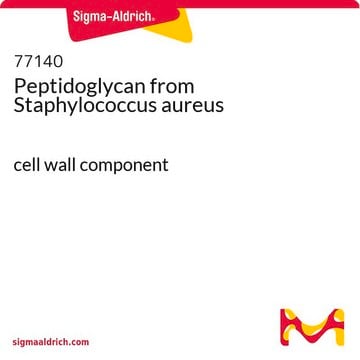L4015
Lipoteichoic acid from Enterococcus hirae
Iniciar sesiónpara Ver la Fijación de precios por contrato y de la organización
About This Item
Productos recomendados
biological source
bacterial (Enterococcus hirae)
Quality Level
form
lyophilized powder
shipped in
ambient
storage temp.
2-8°C
General description
the bacterial source Streptococcus faecalis has been renamed Enterococcus hirae
Biochem/physiol Actions
Lipoteichoic acid (LTA) is a complex component of cell walls of Gram-positive bacteria that are involved in a wide range of cell processes such as the stimulation of immune responses and cell signaling pathways. LTA differs between species of gram-positive bacteria. Lipoteichoic acid from Streptococcus faecalis may be used to compare its structure, immunogenicity and functions versus other bacterial LTAs.
Storage Class
11 - Combustible Solids
wgk_germany
WGK 3
flash_point_f
Not applicable
flash_point_c
Not applicable
ppe
Eyeshields, Gloves, type N95 (US)
Certificados de análisis (COA)
Busque Certificados de análisis (COA) introduciendo el número de lote del producto. Los números de lote se encuentran en la etiqueta del producto después de las palabras «Lot» o «Batch»
¿Ya tiene este producto?
Encuentre la documentación para los productos que ha comprado recientemente en la Biblioteca de documentos.
Zdeněk Zídek et al.
Nitric oxide : biology and chemistry, 23(4), 300-310 (2010-09-21)
Lipoteichoic acid (LTA) is a structural component of the cell walls of Gram-positive bacteria. Similar to lipopolysaccharide (LPS) which is expressed in Gram-negative bacteria, LTA exhibits immunostimulatory properties. Frequently observed positive response of LTA in the Limulus amebocyte lysate (LAL)
G L Card et al.
Journal of leukocyte biology, 56(6), 723-728 (1994-12-01)
The relative activities of lipoteichoic acid (LTA) from four Gram-positive bacteria were compared to different lipopolysaccharide (LPS) preparations for activation of arachidonic acid metabolism in mouse peritoneal macrophages. Total eicosanoid was determined in cultures labeled with [3H]-arachidonic acid. Prostaglandin E2
Tetsuaki Ishikawa et al.
Cell host & microbe, 13(4), 477-488 (2013-04-23)
Various C-type lectin receptors (CLRs), including Mincle and Dectin-2, function as pattern recognition receptors and play a central role in immunity to fungal pathogens. However, the precise structures of the CLR ligands in various pathogenic fungi have yet to be
Anton Steen et al.
The Journal of biological chemistry, 278(26), 23874-23881 (2003-04-10)
The C-terminal region (cA) of the major autolysin AcmA of Lactococcus lactis contains three highly similar repeated regions of 45 amino acid residues (LysM domains), which are separated by nonhomologous sequences. The cA domain could be deleted without destroying the
Christoph Thiemermann
Microbes and infection, 4(9), 927-935 (2002-07-11)
The cell wall of Gram-positive bacteria contains lipoteichoic acid (LTA) and peptidoglycan (PepG), which synergise to cause shock and organ failure in animals, and to activate human blood to release proinflammatory cytokines. The structural elements within LTA and PepG that
Nuestro equipo de científicos tiene experiencia en todas las áreas de investigación: Ciencias de la vida, Ciencia de los materiales, Síntesis química, Cromatografía, Analítica y muchas otras.
Póngase en contacto con el Servicio técnico





